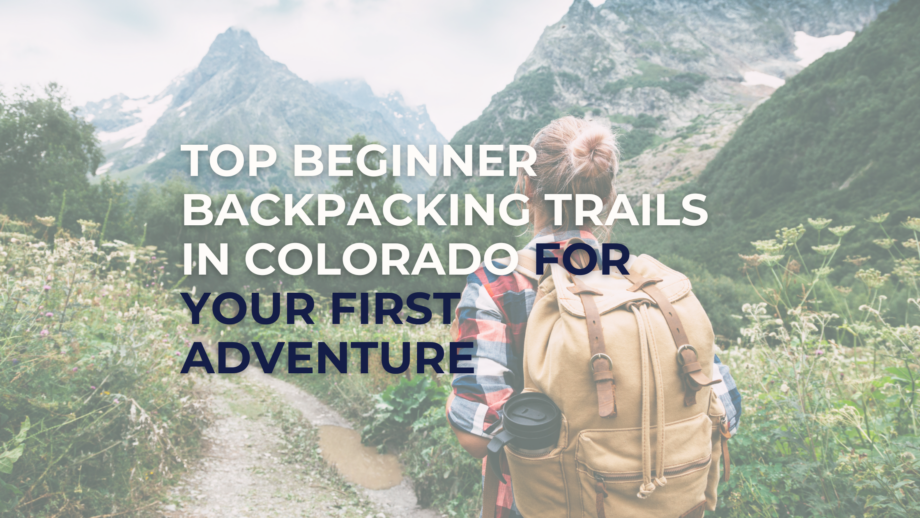Looking to dip your toes into backpacking? Colorado’s diverse trails provide the perfect backdrop for beginner backpackers seeking a rewarding wilderness adventure. In this guide, we’ll explore three of the best backpacking trips: Zirkel Circle, Lone Eagle Peak, and Upper, Middle, and Lower Blue Lakes. Each of these trails is 15 miles or less, making them ideal for those new to backpacking. Whether you’re seeking rugged peaks, serene lakes, or lush meadows, these trails have it all.
Zirkel Circle (Zirkel Loop)
- Location: Mount Zirkel Wilderness
- Distance: 10.4 miles
- Elevation Gain: 2,300 feet
- Highlights: Alpine meadows, scenic lakes, and panoramic mountain views.
The Zirkel Circle is a moderately challenging loop that offers a bit of everything—lush meadows, pristine lakes, and stunning mountain vistas. Starting at the Slavonia Trailhead, you’ll traverse through dense forests and open meadows, encountering Gilpin and Gold Creek Lakes along the way. The trail provides plenty of opportunities to spot wildlife and enjoy the tranquility of the Mount Zirkel Wilderness.
Tips for Backpacking Zirkel Circle
- Best Time to Visit: Late June to early September.
- Camping Spots: Near Gold Creek Lake and Gilpin Lake.
- Trailhead: Slavonia Trailhead.
- Permit: No permits required, but practice Leave No Trace principles.
Mirror Lake and Crater Lake via Cascade Creek Trail (Lone Eagle Peak)
- Location: Indian Peaks Wilderness
- Distance: 15 miles round trip
- Elevation Gain: 2,600 feet
- Highlights: Dramatic peak views, Crater Lake, and serene wilderness.
Lone Eagle Peak is a bucket-list destination for many backpackers. The trail to Crater Lake offers jaw-dropping views of Lone Eagle Peak, one of the most photographed spots in Colorado. The hike is moderately difficult, winding through forests, meadows, and alongside streams. Crater Lake, situated at the base of the peak, provides a perfect campsite with breathtaking views.
Tips for Backpacking Lone Eagle Peak
- Best Time to Visit: Late July to early September.
- Camping Spots: Near Crater Lake.
- Trailhead: Monarch Lake Trailhead.
- Permit: Required for overnight camping in the Indian Peaks Wilderness.
Upper, Middle, and Lower Blue Lakes
- Location: Mount Sneffels Wilderness
- Distance: 8.6 miles round trip
- Elevation Gain: 2,500 feet
- Highlights: Crystal-clear alpine lakes, stunning mountain vistas.
The Blue Lakes trail is a moderately challenging hike that rewards you with views of three stunning alpine lakes. Starting at the Blue Lakes Trailhead, the trail ascends through forests and meadows, with each lake more beautiful than the last. The vibrant blue waters and surrounding peaks make this trail a photographer’s dream. Experienced hikers can also summit the iconic Mount Sneffels from the Blue Lakes trail!
Tips for Backpacking Blue Lakes
- Best Time to Visit: Late June to early September.
- Camping Spots: Near the upper and lower Blue Lakes.
- Trailhead: Blue Lakes Trailhead.
- Permit: No permits required but be mindful of camping regulations.
Essential Tips for Backpacking in Colorado
- Permits and Regulations: Check if your trail requires permits. For example, Lone Eagle Peak requires a permit for overnight stays.
- Weather Preparedness: Colorado weather can be unpredictable. Pack layers and be prepared for sudden changes.
- Altitude Awareness: High altitudes can affect your health. Acclimate, stay hydrated, and be aware of altitude sickness symptoms.
- Leave No Trace: Practice Leave No Trace principles to protect the wilderness. Pack out all trash and minimize your impact.
- Navigation: Bring a map, compass, and possibly a GPS device. Some trails can be poorly marked.
Wrapping Up
Colorado’s Zirkel Circle, Lone Eagle Peak, and Blue Lakes trails offer some of the most stunning and diverse landscapes in the state. Whether you’re tackling the rugged peaks of Lone Eagle, enjoying the serene waters of Blue Lakes, or exploring the lush meadows of the Zirkel Circle, these backpacking trips promise unforgettable experiences. So, pack your gear, hit the trail, and discover the beauty of Colorado’s wilderness.

